Movie reviews and introvert posts from a 40 something introverted developmental psychologist (he/him)
Don't wanna be here? Send us removal request.
Text

It's my 8 year anniversary on Tumblr 🥳
15 notes
·
View notes
Text
Basic Filming Rules Part 2: The 180 Degree Rule and Spatial Orientation
A large part of many movies is dialogue between two characters. It can be very intense, it can be playful, it can be romantic...it can be many things that help the plot progress forward. One thing that cinematographers (and even playwrights) have discovered is that the audience prefers to be on one side of the interaction space wise. It feels like you are standing or sitting in front of the conversation while the scene plays out. It helps the viewer to feel secure in how each character is oriented. If you were sitting at a table, then focusing only on the character on the left means they should be looking towards the right of the camera, while looking at the person on the right means they should be looking to at the left side of camera. It makes logical sense to the eye spatially. To keep this phenomenon of visual orientation in balance, there is a basic rule that filming should be done from one side of a straight line made up by the eyeline of the characters who are interacting. Below is a very basic example from a google image search:

The arrows represent different camera angles and exemplify that the camera can be almost behind the subject and the orientation won't change as long as the shot is taken over the correct shoulder. Changing to the other side of the subjects will suddenly flip the orientation and it seems very weird. It would be like sitting at a play and watching a dinner scene, when suddenly the stage is rotated 180 degrees and you are now seeing the actors from the other direction. It would be very strange. This comforting orientation concept can be seen in films as simple as Bill and Ted's Excellent Adventure (1989), where Bill is almost always on the left and Ted is on the right.



Orientation consistency is pleasing to the eye and the 180 Degree Rule retains this during a scene, so the audience knows (quite literally) where each character stands.
Using Positional Orientation to Help Tell the Story
One of my favorite movies is The Princess Bride (1987), and part of the fun is that battles to the death are treated like very intense conversations. The hero is involved in fencing duals, games of wits, and even wrestling with a giant. These are very extended fight scenes, and the conversation goes on throughout. For this reason, orientation is used along with the 180 Degree Rule. The hero is the Dread Pirate Roberts, who is trying to steal back a princess that has been kidnapped (there is more to it, but I don't want to spoil anything). Roberts takes on a Spanish swordsman named Indigo Montoya and the two switch sides throughout. The continuity works, however, because the fighter with the upper hand tends to be on the left. There is a reveal that each fighter has been using their non-dominant hand to extend the battle, and each time the handicap is made known, then the two switch sides. At the very end, the victor is on the right and he purposeful walks around to the other side before delivering the final blow.

Breaking the 180 Degree Rule to Tell a Story
Another one of my very favorite films is a black and white comedy drama called Paper Moon (1973), and it stars real-life father and daughter Ryan and Tatum O'Neil. The film is about a man (a grifter) who promises to take a little girl to her aunt's house. There is some question about her being the grifter's actual daughter, but he seems to want to use the girl to swindle some people out of guilt money. The grifter convinces a man to give him $200 to take the girl and the little girl believes it should be hers. The movie is set in the late 1930's, so that amount of money would be around $4000 today. She wants that money, she just lost her mother, and this no-good drifter is taking her across country and will likely swindle her if she doesn't do something. They stop at a restaurant and get some food. The grifter is acting like a father figure and telling the girl what to do. The camera angle originates from inside the restaurant and has the two actors at the table as the focus of the shot.
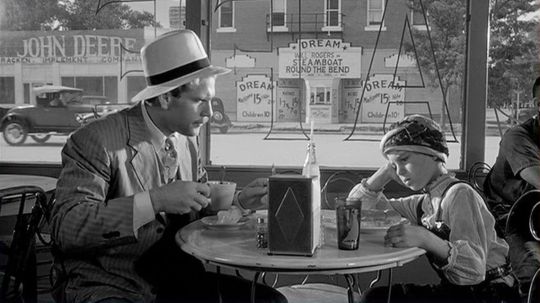
The man grabs some ketchup for the little girl, and she suddenly starts to complain loudly about her $200. The camera is turned 180 degrees and smashes the line to show the actors had switched positions and we are now more aware of all the other people in the scene. The depth of field extends back so the audience can tell that, despite the man wishing for privacy, the whole restaurant is listening to the conversation.

This is a power play by the little girl and this change in the balance of power is displayed by switching the sides of the characters. The tighter shot of the two at the table reflects the man's desire not to have others overhear the conversation, but the long depth of field implies that the other people in the bar can hear everything just fine. It is a brilliant sequence by director Peter Bogdanovich. Even more so, this whole film is extra special as he was advised throughout the production by his close friend and mentor, Orson Welles.
Breaking the 180 Degree Rule in a Bad Movie
I think that this is fast becoming my favorite aspect of these posts. I was watching the movie Catwoman (2004), starring Halle Berry, and the poor filming technique is disorienting throughout the run time. The film has a 9% Rotten Tomato score and took home many Razzies for being basically the worst movie of the year. The acting is just silly, the story doesn't really make sense, and the directing is laughable. I think the cinematography might be the worst aspect of the film (it is so hard to choose), mainly because director Pitof couldn't decide on a shot and just cut everything together in a massive jumble. There are constant circling shots, weird quick cuts, and sudden jumps with no explanation. One thing that actually gives me a headache is that the constantly circling camera crosses the 180-degree line often, so the viewer has no idea of what the spatial orientation is. There is a fight in a jewelry shop in which it makes some sense, but then it is done during a discussion in a boardroom, at the lead characters cubicle, at a little library, during a pickup basketball game, and even just walking down the street. It makes us constantly have to guess who each character is talking to, how the sets are laid out, and where characters are moving. Again, this might make sense in a fight since Catwoman is very quick and agile, which makes it confusing for her opponents. But there are quick cuts and circling shots that cross the eyeline that basically cause motion sickness. It feels like you are on a boat and the prop furniture is constantly shifting and re-orientating itself. Below is a gif of the inappropriate basketball game that has me looking for my Dramamine. This is not skipping around; this is how the movie was apparently intended to look.
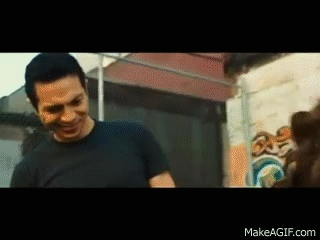
I see some dribbling of a basketball, so I am thinking it is a one-on-one match with these kids watching. Where are they on the court? Got me. Are the kids surrounding the area of play? I'm pretty sure, yes. I also am pretty sure it is half court with a wall on the side (although the camera might be located in the wall at some point?). From watching the whole scene, I believe that the woman (Halle Berry) has cat powers and is trying to attract the man (Benjamin Bratt) with her new skills and confidence. I think the circling is implying that man is changing his opinion about her or that he is confused...maybe? I shouldn't have to guess or make up my own story, the visual telling is the job of the director and cinematographer. This is a mess and an extreme example of crossing over the 180-degree line and destroying any semblance of spatial orientation.
----------------------------------------------------------------------------
Where actors are placed in relation to the camera is very important. This can be used to keep the audience calm and orientated to time and space, or it can be used to purposefully cause chaos and confusion. Subtle details in the shooting can help tell the story, or it can inadvertently confuse the audience as to what the heck is going on. No matter how it is used, spatial orientation and the 180 Degree Rule are good basic things to always keep in mind when filming.
#the princess bride#paper moon#catwoman#film making#camera tricks#film school#introvert#bill and ted
20 notes
·
View notes
Text
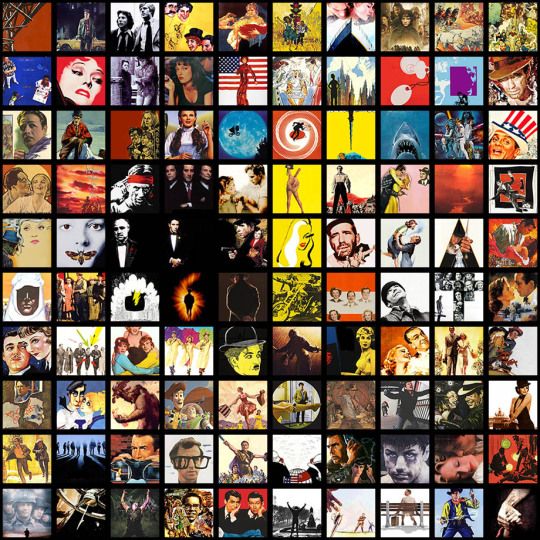
Well, after almost 4 years of watching films, the group and I finally made it through all 100 films. Besides just watching the films, this project also included one hundred reviews that ranged between 1000 and 3000 words each, one hundred short introductions for each film, and 138 movie related side posts. In total, it accounts for a little over 300,000 words and over 400 double-spaced pages describing all the movies on the list. It has been quite the journey and helped me keep my sanity during a rather rough time for world. I still would like to review movies and learn about filmmaking, but I think I am done with this AFI list for a while. Below are all the movies in the order that I saw them, along with the year they were released, the AFI ranking from the 10th anniversary list, and the day that I watched the film. It has really been a pleasure.
1 Blade Runner 1982 #97 8/15/18 2 Raging Bull 1980 #4 8/24/18 3 Jaws 1975 #56 8/26/18 4 To Kill a Mockingbird 1962 #25 9/1/18 5 The Searchers 1956 #12 9/10/18 6 Sunrise: A Song of Two Humans 1927 #82 9/15/18 7 Unforgiven 1992 #68 9/21/18 8 Double Indemnity 1944 #29 9/24/18 9 The Godfather 1972 #2 9/30/18 10 Raiders of the Lost Ark 1981 #66 10/4/18 11 Annie Hall 1977 #35 10/8/18 12 One Flew Over the Cuckoo's Nest 1975 #32 10/13/18 13 12 Angry Men 1957 #87 10/18/18 14 Psycho 1960 #14 10/25/18 15 Cabaret 1972 #63 11/10/18 16 Last Picture Show 1971 #95 11/22/18 17 Godfather 2 1974 #32 11/30/18 18 Ben-Hur 1959 #100 12/10/18 19 It's a Wonderful Life 1946 #20 12/27/18 20 Snow White 1937 #34 1/7/19 21 In the Heat of the Night 1967 #75 1/12/19 22 Sophie's Choice 1982 #91 2/2/19 23 The Philadelphia Story 1940 #44 2/11/19 24 The Sixth Sense 1999 #89 2/19/19 25 West Side Story 1961 #51 2/22/19 26 ET 1982 #24 3/22/19 27 A Night at the Opera 1935 #85 4/18/19 28 Apocalypse Now 1979 #30 6/24/19 29 Swing Time 1936 #90 7/5/19 30 Yankee Doodle Dandy 1942 #98 7/21/19 31 Rear Window 1954 #54 7/28/19 32 All About Eve 1950 #28 8/29/19 33 The General 1926 #18 9/13/19 34 Tootsie 1982 #69 10/1/19 35 Rocky 1976 #57 10/12/19 36 Shane 1953 #45 10/30/19 37 Who's Afraid of Virginia Woolf 1966 #67 11/14/19 38 Sunset Boulevard 1950 #16 11/28/19 39 Vertigo 1958 #9 12/15/19 40 Singin in the Rain 1953 #5 1/15/20 41 Nashville 1975 #59 1/25/20 42 Bringing Up Baby 1938 #88 2/2/20 43 Midnight Cowboy 1969 #43 2/6/20 44 Spartacus 1960 #81 3/7/20 45 Network 1976 #64 3/11/20 46 Butch Cassidy and the Sundance Kid 1969 #73 3/23/20 47 Sullivan's Travels 1941 #61 4/11/20 48 On the Waterfront 1953 #19 4/25/20 49 Lord of the Rings 2001 #50 5/8/20 50 All the President's Men 1976 #77 5/12/20 51 Casablanca 1942 #3 5/17/20 52 North by Northwest 1959 #55 5/25/20 53 The Gold Rush 1925 #58 6/4/20 54 Toy Story 1995 #99 6/20/20 55 The French Connection 1971 #93 7/11/20 56 City Lights 1931 #11 7/25/20 57 Some Like it Hot 1959 #22 8/8/20 58 Gone with the Wind 1939 #6 8/30/20 59 Goodfellas 1990 #92 9/19/20 60 High Noon 1952 #27 9/30/20 61 King Kong 1933 #41 10/12/20 62 The Silence of the Lambs 1991 #74 10/25/20 63 The Bridge on the River Kwai 1957 #36 10/30/20 64 The Graduate 1967 #17 11/18/20 65 Wizard of Oz 1939 #10 12/22/20 66 The Apartment 1960 #80 12/26/20 67 Intolerance 1916 #49 1/3/21 68 MASH 1970 #54 1/20/21 69 Dr Strangelove 1964 #39 1/25/21 70 Saving Private Ryan 1998 #71 2/11/21 71 Do the Right Thing 1989 #96 2/24/21 72 Pulp Fiction 1994 #94 3/7/21 73 A Clockwork Orange 1971 #70 3/19/21 74 Chinatown 1974 #21 3/25/21 75 The Sound of Music 1965 #40 4/10/21 76 Duck Soup 1933 #60 4/15/21 77 Easy Rider 1969 #84 4/23/21 78 Star Wars 1977 #13 5/4/21 79 The Maltese Falcon 1941 #31 5/10/21 80 The Treasure of the Sierra Madre 1948 #38 5/19/21 81 African Queen 1951 #65 5/26/21 82 Lawrence of Arabia 1962 #7 6/1/21 83 Bonnie and Clyde 1967 #42 6/6/21 84 Schindler's List 1993 #8 6/26/21 85 Modern Times 1936 #78 7/19/21 86 The Best Years of Our Lives 1946 #37 8/8/21 87 Taxi Driver 1976 #52 10/13/21 88 Mr. Smith Goes to Washington 1939 #26 10/29/21 89 The Shawshank Redemption 1994 #72 11/13/21 90 American Graffiti 1973 #62 12/8/21 91 A Streetcar Named Desire 1951 #47 12/13/21 92 The Wild Bunch 1969 #79 12/26/21 93 Titanic 1997 #83 2/1/22 94 It Happened One Night 1934 #46 2/15/22 95 The Deer Hunter 1978 #53 3/25/22 96 2001: A Space Odyssey 1968 #15 4/22/22 97 Forrest Gump 1994 #76 5/1/22 98 Platoon 1986 #86 5/11/22 99 The Grapes of Wrath 1940 #23 6/1/22 100 Citizen Kane 1941 #1 6/26/22
If you look at the archive for this blog, you can find reviews of every one of these films along with side essays about the characters and the production surrounding the films. Feel free to ask questions, because I know the whole list quite well at this point.
17 notes
·
View notes
Text
Citizen Kane (1941); AFI #1



The final movie under review from the AFI top 100 is the classic that was ranked #1 both originally and for the 10th anniversary of the list. It is, of course, the Orson Welles masterpiece Citizen Kane (1941). This film has become synonymous with fine film in the United States and truly is the height of art in the medium. The dramatic angles, the shadowing, the use of deep focus, and the constant use of symbolism makes this film stand out from almost any other. The film was nominated for nine Academy Awards, but only won one award for Best Original Screenplay. There was quite a bit of controversy around this film at the time since it is very similar to the life story of William Randolph Hearst. Hearst owned a lot of newspapers at the time and prevented reviews for the movie, causing a lack of real recognition until sometime in the 70s. I will try to go over the plot as much as possible before looking closer at some of the many fine touches that makes the movie so amazing, but it is really deep and difficult to encapsulate in a short review. Let's start with our standard warning about plot twists...
SPOILER WARNING!!! A MYSTERY IS PRESENTED AT THE BEGINNING OF THE FILM THAT ISN'T REVEALED UNTIL THE ENDING!!! WE'RE TALKING FIRST TWO MINUTES VERSUS THE LAST MINUTE!!! THE WHOLE MOVIE IS DRIVEN BY THIS SINGLE MYSTERY AND I DON'T WANT TO SPOIL IT FOR ANYBODY!!! CHECK IT OUT BEFORE READING THIS REVIEW BECAUSE I WILL ADD A LOT BEYOND JUST THE PREMISE OF THE FILM!!! COME BACK WHEN YOU ARE DONE!!!
---------------------------------------------------------------------------
In a mansion called Xanadu, part of a vast palatial estate in Florida, the elderly Charles Foster Kane (Orson Welles) is on his deathbed. Holding a snow globe, he utters a word, "Rosebud", and dies. There is an extreme close-up on his lips as he gives his final words. The snow globe rolls out of his hand and breaks on the ground. A nurse is reflected in the broken glass as she comes in to find the dead body. The audience is aware at this point that the film will put a magnifying glass to the life of Kane so we can decide what this word means.
A newsreel obituary tells the life story of Kane in the news. He is presented as an enormously wealthy newspaper publisher and industrial magnate. Kane's death becomes sensational news around the world, and the newsreel's producer tasks reporter Jerry Thompson (William Allund) with discovering the meaning of "Rosebud".
Thompson sets out to interview Kane's friends and associates. He tries to approach his second wife, Susan Alexander Kane (Dorothy Comingore), now an alcoholic who runs her own nightclub, but she refuses to talk to him. Thompson decided he will circle back around to see her since she is inconsolable at the time. Thompson goes to the private archive of the late banker Walter Parks Thatcher (George Coulouris). Through Thatcher's written memoirs, Thompson learns about Kane's rise from a Colorado boarding house and the decline of his personal fortune. The lighting in the scene when Thompson goes into the record room is highly symbolic. Everyone is in shadow while the table and book are in almost angelic bright light, showing that the answer to the Rosebud question is mentioned somewhere in the memoirs.
In a flashback to Kane's childhood, gold was discovered in 1871 through a mining deed belonging to Kane's mother, Mary Kane (Agnes Moorehead). She hired Thatcher to establish a trust that would provide for Kane's education and to assume guardianship of him. While the parents and Thatcher discussed arrangements inside the boarding house, the young Kane played happily with a sled in the snow outside. When Kane's parents introduced him to Thatcher, the boy struck Thatcher with his sled and attempted to run away. It is made apparent that the little shed-sized house that Kane grew up in is the little house in the broken snow globe from the beginning of the film.
In a bunch of quick flashes forward, it is shown that, by the time Kane gained control of his trust at the age of 25, the mine's productivity and Thatcher's prudent investing had made Kane one of the richest men in the world. He took control of the New York Inquirer newspaper and embarked on a career of "yellow" journalism, publishing scandalous articles that attacked Thatcher's (and his own) business interests. Kane sold his newspaper empire to Thatcher after the 1929 stock market crash left him short of cash. Thompson is shown leaving Thatcher's memoir room in shadow while the book remains in bright light, showing that Thompson had missed the answer and failed to become "enlightened."
Thompson interviews Kane's personal business manager, Mr. Bernstein (Everett Sloane). Bernstein recalls that Kane hired the best journalists available to build the Inquirer's circulation. Kane rose to power by successfully manipulating public opinion regarding the Spanish American War and marrying Emily Norton (Ruth Warrick), the niece of the President of the United States. It becomes apparent that the memories of Kane are exaggerated, or at least influenced, by the perspective of the person telling the story. Thatcher had many focused in shots in which he spoke directly to camera because it was a memoir. He was speaking to a general audience for posterity. He also had almost all of his encounters in a cold banker's office and the mood was affected by the news given, which was shown in the shadowing. Bernstein remembered Kane as a fun-loving boss that was the life of the party, so his memories have a musical number and Kane is always young, handsome, and full of spirit.
Thompson interviews Kane's estranged best friend, Jedediah Leland (Joseph Cotton), in a retirement home. (Side note that this was the first major film role of Joseph Cotton in what would be a 40-year career that included almost 100 movies. Seeing the phrase "introducing Joseph Cotton" at the end was really a weird moment) Leland says that Kane's marriage to Emily disintegrated over the years, and he began an affair with amateur singer Susan Alexander while running for Governor of New York. Both his wife and his political opponent discovered the affair, and the public scandal ended his political career. Kane married Susan and forced her into a humiliating operatic career for which she had neither the talent nor the ambition, even building a large opera house for her. After Leland began to write a negative review of Susan's opera debut, Kane fired him but finished the negative review and printed it. Leland seems to remember things more in terms of size and space, so relationships are shown by how far apart the characters are seating or standing from each other. Power is shown by how big the character is on screen or whether the camera is shooting upwards (more power) or downwards (less power).
Susan finally consents to an interview with Thompson and describes the aftermath of her opera career. Susan is not very smart and actually quite childish in manner. Kane is shot almost as if he was being viewed by a child, and the house at Xanadu seems comically large with a mammoth fireplace that is bigger than the actors. All of the lines echo in the vast emptiness, even though Susan often has to repeat herself since she didn't feel like she was being heard. Kane finally allowed her to abandon singing after she attempted suicide. After years spent dominated by Kane and living in isolation at Xanadu, she left him. Kane's butler Raymond recounts that, after Susan left him, he began violently destroying the contents of her bedroom. When he happened upon a snow globe, he grew calm and said "Rosebud". Thompson concludes that he is unable to solve the mystery and that the meaning of Kane's last word will forever remain a mystery.
Back at Xanadu, Kane's belongings are cataloged or discarded by the staff. They find the sled on which the eight-year-old Kane was playing on the day that he was taken from his home in Colorado and throw it into a furnace with other items. Behind their backs, the sled slowly burns, and its trade name becomes visible through the flames: "Rosebud".
------------------------------------------------------------------------------
I can't put into words how much I have gotten out of this film each time I have seen it. It has been more than a dozen times and I am astounded by how dense it is on each review. The way that the story is recounted through the memories of those people with different relationships with Kane is phenomenal. The way that the visuals change to match the mindset and complexity of the character is amazing. The use of lighting, props, and camera angles is not like anything that had come before it. For me, this film is pure genius from beginning to end.
The sets and camera effects in this film are phenomenal. This was a black-and-white film, so intense colors were replaced with spectacular light and intensely exaggerated set pieces. The absolutely cavernous house of Kane and his second wife with the absolutely huge fireplace really emphasized how small and lonely she felt in that home. An exceptionally impressive shot is the opening of the opera that the second wife performed in. When recalled from the point of view of Leland, it is the audience view and we can see all the actors. The camera pans up into the rafters and it appears almost like a puppet show, which is how Leland views the whole production. We see the same moment from Susan's view, and it is from just behind her and it appears she is alone on stage, staring into an abyss of darkness. I can't say enough about the attention to detail in this film with all the shots.
An iconic scene is when Kane is running for governor and there is a huge picture of himself looking down on the crowd. This is a memory of Leland's, so it represents how big-headed and egotistical that Kane had become at this moment. Separate pictures are used throughout the film to show where Kane's ego was at any given time in his life. However, the man that he is running against has dirt on Kane and this character is seen high above the rally, looking down on a miniscule Charles Foster Kane and all of his followers.
After Kane eventually loses the election, there is a return back to the office and all of the shots are from an incredibly low angle. This was still the memory of Leland, and everybody was still thinking they were too big for their little newspaper office. Orson Welles and his cinematographer, Gregg Tolland, actually broke the sound stage so they could place the camera at ground level to get that crazy upward angle at the actors. Welles also would have actors carefully lit in both the foreground and background to help tell the story, so Tolland found a way to create a huge depth of field (they called it deep focus) so that many characters could be in full focus at the same time. Welles and Tolland were inventing some of the language of film on the fly. This entire picture was a huge step forward towards how we view and understand film today. Welles was so appreciative of Tolland that he put Tolland's credit on the same card as his own, something that was never done since producer/directors generally took total creative credit for their movies.
Speaking of creative credit, there remains to this day an argument over who had the "real" writing credit for this film. A man named Herman Mankiewicz made a rough outline about the story of William Randolph Hearst after he and Welles had reportedly come with the idea together. Welles gave Mankiewicz 300 pages of notes to doctor up the script, and Mankiewicz made a more coherent story. There was a contract which Mankiewicz signed that said he would take no writing credit, but he changed his mind right before the film came out. Both Welles and Mankiewicz ended up with writing credits, and it seemed like it was settled at that point. A famous film critic named Pauline Kael revisited the subject in 1971 with a book length article in The New Yorker downplaying Welles contribution to the script. More thorough investigations have since been made and the general consensus is that Welles and Tolland made daily script changes to every aspect of the Mankiewicz screenplay to the point that the final product was very little like what Mankiewicz had in mind.
No matter who got the final writing credit, it is very assured that the subject of the film had always been a representation of William Randolph Hearst, a person whom neither writer was a fan of. Hearst had used his massive wealth and influence to persuade public opinion and this film was an obvious shot at him. Hearst was the owner of many newspapers, he cheated on his wife with actress Marion Davies, and he created a huge mansion out in San Simeon (still there if you want to visit) known as Hearst's castle. Hearst dabbled in politics and lost many elections because of his romantic scandals. Hearst was even given partial blame for the Spanish American War, which his papers propagated due to the increase circulation following the sinking of the USS Maine that started the conflict. Hearst did not enjoy the ribbing and refused to advertise or critique the film in any paper he had influence over and blocked the theatre distribution as much as he could. The film did eventually receive 9 nominations for Academy Awards, but strangely only garnered one win (maybe not so coincidentally?).
The film is a passion project for Welles and is a political shot from a low budget movie in which the writer, producer, director, and lead actor are all the same person. Given those dynamics today, I would have guessed that this movie would have been awful, especially from a first-time film maker. If only one of the scenes actually told the story and the rest was just filler nonsense, I would probably think this film was pretentious. The dedication, however, that Welles had to having every shot, every scene, every shadow, every movement, and every set piece contribute to the story makes it a masterpiece. He even bled for the role. In the room trashing scene after Susan leaves Kane, Welles cut his hands severely to the point that they were openly bleeding from broken glass wounds. He finished the scene and did not do a second take, but he said he was cut early and could definitely feel his wounds throughout the take.
So, does the film deserve to be number one spot on the AFI top 100? It is debatable, but I think so. It is an American story about one of the great American influencers that contributed vastly to the language of film. Whether you consider it more about Hearst or about Welles, these were the biggest names on the national stage at the time. Also, having a young director just go out and break all the rules to tell a story against a national bully of the time sounds so American. It is not my favorite movie of all time, but I believe it is the most influential American production of all time and deserves the number one spot. Would I recommend it? Oh god, yes. The film is amazing, and it is more impressive with each watch. I could spend a week explaining all the things worth noting. In fact, I took a film class in the late 90s in which we spent 3 weeks discussing all the different aspects of the movie, and we didn't come close to covering everything. If you consider yourself a fan of film, then you should see this as a treat for yourself. Undeniably a film everyone should see at least once before they die.
#william randolph hearst#orson welles#citizen kane#best rated films#movies#black and white#great movies#movie review#movie recommendation
6 notes
·
View notes
Text
Basic Filming Rules Part 1: Depth of Field and Point of Focus
There is a basic language of film that allows the audience to understand the story that is being related by a director. One of the major aspects of filming is putting those things that you want the audience to pay the most attention in focus. What the viewer pays attention to changes the story being told. Not being able to know where to look can cause confusion. The last thing that a good director wants to give off is a muddled message.
This concept of mixed messages is partially because a camera can allow many things to be in focus at the same time. The distance between the closest thing in focus and the furthest thing in focus is known as the depth of field. If used correctly, this aspect of what you see on the screen can have an effect on how the story is interpreted. In the figure below are three identical scenes, but the depth of field changes the expectation due to context. In the top situation, there is just a shark in focus with blurry objects around it. This means that the shark is the only point of interest, and the viewer can focus their attention on the details of that aquatic animal. In the middle situation, the depth of field includes both the shark and the fish in front of it, implying that the shark is hunting this fish. In this situation, it is likely that the little fish is about to become a snack for the shark. Finally, in the bottom scene, there is a shark between a small fish and a plant. Since all three items are in focus, the audience will expect that the three will interact with each other. It is more likely that the shark is hunting the smaller fish and the smaller fish will attempt to get past the shark to the safety of the plant. The point of focus tells us the main character, but the depth of field tells us the setting and the other characters plus implications of interaction.
DEPTH OF FIELD AND FOCUS
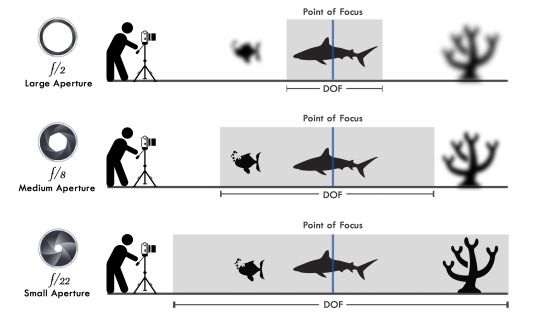

The picture of the woman above shows a smaller depth of field on the left. The focus is on her alone with the extreme foreground and background being blurred focuses the viewer's attention is on her alone which makes one consider what she is wearing, the way she is sitting, and even her expression. She is the only point of focus; that picture is about her. The same woman on the right is in a picture with a much larger depth of field and it allows the viewer to acknowledge the setting. Where is she? Why is she there? Her hair, her necklace, and the pattern on her dress seem to be mimicking the hanging branches around her. There is an open field behind her. Is she attempting to blend in? Is she hiding from something in the woods behind her? It all depends on what story the director wants to tell. Here are some examples of how depth of field can be used (or misused) in the context of cinematography.

Using Depth of Field to Create Unease and Chaos
In one of the earlier scenes in the movie The Revenant (2015), there is an attack on the fur trader camp by the Arikara natives. The camera follows many different characters and constantly scans all over the scene. There are no cuts for a long period of time, and the depth of vision is as large as possible. This does not give the audience a sense of where to look and that danger could be coming from anywhere. It replicates that sense of panic and surge of adrenaline when there is life-or-death danger resulting in utter chaos. It is very confusing for the viewer and causes almost a nauseating feel while trying to figure out what needs to be done to escape. The story is completely put on hold for 5 minutes of utter confusion...and that is the story that the director wanted to tell. Goals and destinations did not really matter for this brief moment in time, only survival. There are brief moments when there will be focus on a single yelling character, almost as if their words are sinking in amongst the carnage. But then that person will be silenced by death or by engagement in battle and the point of focus changes. Director Alejandro Gonzalez Iñárritu used similar techniques in his other films, including Birdman (2014) and Babel (2006), but never before as well as he did in this film. A majority of the credit should go to the Director of Photography, Emmanuel Lubezki, who was able to capture the chaos by adjusting the aperture (change the focus and depth of field) while chasing the action through a forest for one long, practically seamless cut.
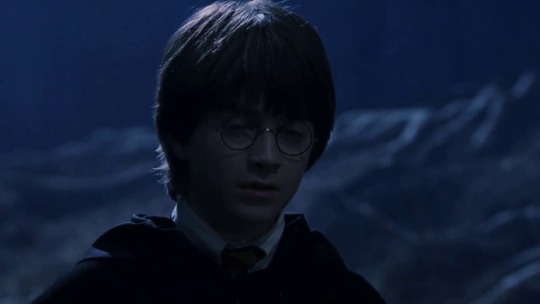

Using Depth of Field for a Visual Gag
I remember seeing the first Harry Potter movie back in the early 2000s and thought it was a lot of fun. I especially appreciated the dark tone despite it being a children's film (I was not as familiar with the Young Adult genre at the time). It reminded me a lot of the dark fantasy films like Legend, The Dark Crystal, or The Never-Ending Story. One scene in particular made me laugh very hard when I rented and rewatched the Harry Potter film, and for the longest time I could not tell why. It is the scene when Harry first encounters Voldemort in the Forbidden Forest and Malfoy runs away like a coward. When Harry and Malfoy first encounter the cloaked figure, there are a couple of close-up shots of the boys' faces where the depth of field is very short leaving the forest to look hazy in the background. This tells us that the boys feel trapped because they are alone with this creature, surrounded basically by the dark unknown. Not funny and very serious. But Malfoy then screams and runs away with the large dog that is supposed to be protecting them. Slightly comical but still serious. We then get a shot of Harry, and the depth of field is actually extended into the background pretty far which made me think that Hagrid (the giant that was supposed to be protecting them) or something else would come from behind. However, I was fooled because, instead of a savior or perhaps something worse, Malfoy runs across the back of shot still screaming and carrying the only lamp. It gives the audience hope for a second that something will save Harry and instead solidifies that he is probably screwed because the only beings that knew where he was were running away in a panic and taking the only light source and possible source of protection. It is this feeling of "maybe there will be help after all...nope, still screwed" that makes me laugh each time. Eventually, a creature does come to the rescue from that direction at the last possible moment, but that subversion of expectations with a simple film trick is genius in my opinion.

Completely Screwing Up with Depth of Field
One of my favorite things about having a very basic understanding of filming is you can actually understand why bad films are so awful and get a good chuckle out of it. A personal favorite bad movie is the film R.O.T.O.R. (1987), which tells the story of a cyborg cop that goes crazy and starts killing people for minor infractions. It sounded like a mix between The Terminator and Robocop, so I checked it out. It had been covered by both RiffTrax and RedLetterMedia by the time I saw it, so I knew that it was supposed to be comically bad. The particular scene depicted above is snipped from YouTube (you can watch it for free with ads), and it is the ending action scene from the movie. You wouldn't know that from the clip, though. The blonde guy and the woman in red are trying to escape as the woman kicking by the lake is fending off the cyborg cop. The cinematography is telling me that there is fighting in the background that is unimportant to the story. I would then assume that the people in the foreground are the point of interest, and we will follow them. Nope. The next shot focuses on the two people fighting by the lake. If you look closely, the point of focus in this shot is actually a little cord that goes through the scene and attaches to the tree on the right. That means it's important, right? Nope. So, this shot contains a cyborg death match and the fleeing protagonists, but focuses on a little cord that is in between them? Yep. This shot goes on for about 5 seconds and it is completely confusing in the funniest way. This is a perfect example of how to screw up depth of field.
-----------------------------------------------------------------------------
There is so much more to a good movie than just the pictures in front of your face. There is often a story within the story, and one needs to recognize the tools to truly appreciate the full effort and the message that is in a film. I feel like it is the understanding of filmmaking at this deeper level that really allows a viewer to enjoy film.
#depth of field#cinematography#language of film#understanding media#psychology#point of focus#film school
62 notes
·
View notes
Text

After almost 4 years of reviewing AFI films, we are finally to the top of the list with the classic Citizen Kane (1941). I saw this film with my mom back when the first AFI list came out and then I saw it twice in two different college film classes. I have since seen it a dozen more times and I agree that it truly is brilliant. Orson Welles wrote, directed, and starred in this, making it perhaps the best triple threat passion project in film history. This film was ranked number one on the AFI top 100 in 1997 and again in 2007. I am truly looking forward to reviewing this film because I find something new every time I watch it. Here is the trailer to give you an idea of what our group will be treated to:
(2) Citizen Kane (1941) Official Trailer #1 - Orson Welles Movie - YouTube
1 note
·
View note
Text
The Grapes of Wrath (1940); AFI #23




The penultimate film under review for the AFI top 100 was the movie adaptation of the John Steinbeck classic, The Grapes of Wrath (1940). This movie was directed by the great John Ford and starred great acting talents Henry Fonda and John Carradine. The source material had come out just the year previous, so it was actual a pretty quick production. The way the story is laid out (half road trip and half in shanty towns) makes it a pretty easy project to film. John Steinbeck did not understand this, because he did not believe the film would ever have a faithful adaptation. The book was initially published in 1939, and it only took a year for the movie to be adapted and completed. According to movie critic George Bluestone, "If the novel is remembered for its moral anger, the film is remembered for its beauty (study.com)." The production deserves more attention, but let's go over the story first.
SPOILER ALERT!!! I AM ABOUT TO SPOIL ONE OF THE BEST LOVED AMERICAN CLASSICS IN BOTH FILM AND BOOK FORM!!! PLEASE CHECK OUT EITHER BEFORE HAVING THE STORY LINED SPOILED!!!
-----------------------------------------------------------------------------
The film opens with Tom Joad (Henry Fonda), recently released from prison and hitchhiking his way back to his parents' family farm in Oklahoma. Tom finds an itinerant man named Jim Casy (John Carradine) sitting under a tree by the side of the road. Tom remembers Casy as the preacher who baptized him, but now Casy has "lost the spirit" and his faith. Casy goes with Tom to the Joad property, only to find it deserted. There, they meet Muley Graves, who is hiding out. In a flashback, he describes how farmers all over the area were forced from their farms by the deedholders of the land, and had their houses knocked down by Caterpillar tractors. Tom soon reunites with his family at his uncle's house. All of the Joads (including Jane Darwell as Ma and Russel Simpson as Pa) have planned to migrate with other evicted families to the promised land of California. They pack everything the next day into a dilapidated 1926 Hudson "Super Six" adapted to serve as a truck in order to make the long journey. Casy decides to accompany them.
The trip along Highway 66 is arduous, and it soon takes a toll on the Joad family. The elderly Grandpa dies along the way. Tom writes the circumstances surrounding the death on a page from the family Bible and places it on the body before they bury it, so that if his remains were found, his death would not be investigated as a possible homicide. They park in a camp and meet a man, a migrant returning from California, who laughs at Pa's optimism about conditions in California. He speaks bitterly about his experiences in the West. Grandma dies when they reach California. The son, Noah, and son-in-law, Connie, also leave the family group.
The family arrives at the first transient migrant campground for workers and finds the camp is crowded with other starving, jobless, and desperate travelers. Their truck slowly makes its way through the dirt road between the shanty houses and around the camp's hungry-faced inhabitants. Tom says, "Sure don't look none too prosperous."
After some trouble seen between the sheriff and an agitator, the Joads leave the camp in a hurry. The Joads make their way to another migrant camp, the Keene Ranch. After doing some work in the fields, they discover the high food prices in the company store. The store is also the only one in the area by a long shot. Later they find a group of migrant workers are striking, and Tom wants to find out all about it. He goes to a secret meeting in the dark woods. When the meeting is discovered, Casy is killed by one of the camp guards. As Tom tries to defend himself from the attack, he inadvertently kills the guard.
Tom suffers a serious wound on his cheek, and the camp guards realize it will be easy to identify him. That evening, the family hides Tom under the mattresses of the truck, just as guards arrive to question them; they are searching for the man who killed the guard. Tom avoids being spotted and the family leaves the Keene Ranch without further incident. After driving for a while, they must stop at the crest of a hill when the engine overheats due to a broken fan belt; they have little gas but decide to try coasting down the hill to some lights. The lights are from a third type of camp: Farmworkers' Weedpatch camp, a clean camp run by the Department of Agriculture, complete with indoor toilets and showers, which the Joad children had never seen before.
Tom is moved to work for change by what he has witnessed in the various camps. He tells his family that he plans to carry on Casy's mission in the world by fighting for social reform. He leaves to seek a new world and to join the movement committed to social justice.
-----------------------------------------------------------------------------
I really appreciate the character of Tom Joad because he was one of my first experiences as a definitive anti-hero. He is pushy and a troublemaker, he seems almost proud that he was in jail because he killed a guy, and he even harasses the nice old man that gives him a ride from the very beginning. Tom Joad is not a very nice guy. But he is a good man and wants to do what is right and what is fair. He also wants to do what is right for his family and for people who are just trying to get by. Upon examination, he is the biggest hurdle for the family's survival in the end, and that is why he leaves. He is adolescent angst personified with the simple thought of "they would be better off without me." The title is so appropriate because "nothing but trouble" is harvested from this approach of anger.
Jane Darwell, who plays Ma Joad, won the Academy Award for Best Supporting Actress and this was especially deserved. She was perfect as the touching point of compassion and sanity for an angry Tom Joad. She looked the part, acted the part, and the character was so well written...this was one of the most deserving Oscars that I know of.
One thing that I had heard about but always thought was a children's rumor was that the book was banned in schools, especially California schools, and that the movie was not shown in many Hollywood theatres. I found that this was actually true due to the language and the poor depiction of many Oklahoma settlers that moved to California and their subsequent treatment. I grew up in Santa Maria in Central California (it was originally called Central City) and I was aware that there was a large farming community that identified with Texas and Oklahoma. But these were my friends and schoolmates and I thought of the story as a dramatized history and not something insulting. I have never been a fan of pre-judging somebody purely on their culture or their past.
I did a little side project with some of my summer students to follow the path that the family must have taken to get from their farm to Needles, California. I have been to Needles, and it is just awful as far as heat. It is the mast stagnating weather, especially during summer, and I can't imagine how difficult of a job picking peaches was in that heat. Not to be morbidly practical, but it might have been better that the grandparents passed because they would have been another mouth to feed, and they would not have been able to work in the fields. It takes a sad situation for me to even consider something like that, but this movie definitely did that to me.
I want to take note of the cinematography in this film. It is hard to get those fantastic panoramic shots in black and white, but the director of photography managed to do it. There were obviously a lot of sets and sound stages (that is what they had at the time), but there were definitely some shots in California and Arizona. Very well shot for the time.
I believe that there was a little "behind the scenes" politics as the 1941 Academy Awards because this film did not get best adapted screenplay. This is an American classic and a wonderful story, but it lost to the Katherine Hepburn comeback piece, Philadelphia Story, that was backed by Howard Hughes. There is nothing wrong with the play for Philadelphia Story and it was a cute romantic comedy, but it was nowhere near the level of The Grapes of Wrath. Hughes had a whole lot of money and anything that he backed at that time seemed to come up a winner. Very suspicious.
So, does this film belong on the AFI top 100 movie list? Of course. This is a movie that was part of the first round of inductees to congress for national heritage. It is based on a Pulitzer-prize winning novel by a classic American author. It was about the plight of American Midwest farmers during the Great Depression. It is a great film and about as American as you can get. Would I recommend it? Of course. Great story. I would recommend the book, the movie, and the play. It is a great telling of American history that deserves all of the praise that it has been given. I especially recommend the movie for students studying US history that want to better understand Great Depression era literature.
#black and white films#the great depression#john ford#henry fonda#best director#award winning#introvert#introverts#great movies#films
6 notes
·
View notes
Text
Depression Era Travel on Route 66
I still tutor professionally while trying to get a degree as an education specialist (working on the math portion of it right now), and one of the things that I have been doing is working with students over the summer to prepare for SAT/ACT and to keep their minds fresh. This is kind of difficult because nobody in the standard American school system wants to think about school subjects over their break. I try to make it as fun as I can, which is one of the reasons I have been incorporating this AFI research into my sessions. I don't know if my students love it, but all of the parents that I work with definitely do.
One thing that we do often is take a deep dive on the interwebs to find out what it is like to live in American history, as depicted in the different films that we are watching. Many of the students I have are going into the dreaded AP US History (APUSH), so we go through some major events like the Civil War and the Great Depression that show up in that class. In the current film under review, The Grapes of Wrath (1940), there is a full family road trip from Oklahoma to the border of California. I got comments that "moving sucks" and "long road trips are the worst" from my students, but I don't think we realized how bad it had to have been. Three different students and I went over the journey, and we found some pretty interesting things.
SPOILER ALERT!! I WON'T GIVE AWAY THE ENDING, BUT THERE ARE SOME REVEALS ABOUT SMALL CHARACTERS FOR BOTH THE BOOK AND THE FILM!!
The timing is not 100% clear in the film, but it is set during the time of the peach harvest of the early 1930s at the beginning of the Great Depression. The trip starts in Sallisaw, Oklahoma and the trip ends in Needles, California. There is more driving that is done upon arrival in California, but that initial drive is from these two points. Spoiler: there are 10 people that pile into an old truck that is filled with other possessions and the trip actually kills the two grandparents. Is it such a difficult trip that people could actually die? The film does not focus much on the trip, but analyzing it taught my students and I that it would have been pretty brutal.
There was a flyer the family had that advertised work picking peaches in California, which is considered to be from late June to September (it's a summer harvest). Home refrigerators had been invented in the 1880s and popularized with freon in the 1910s. The cold process had been simplified and there was widespread use of the technology by the 1920s. This meant that produce was likely in higher demand because it could be kept longer. It makes sense that there would be high demand for pickers in the fields. There had been an amazing drought in the plains of the United States, giving it the unfortunate nickname of the "Dust Bowl." This meant that many farms were not producing and thus foreclosed on, forcing the former owners to leave their family homes and go where the work was. The influx of farm workers from the South that were desperate for money meant farm owners in California could advertise and then attract thousands of families that would work for cheap. It was a terrible situation that forced many families like the Joads to make the trip along Route 66 to California.
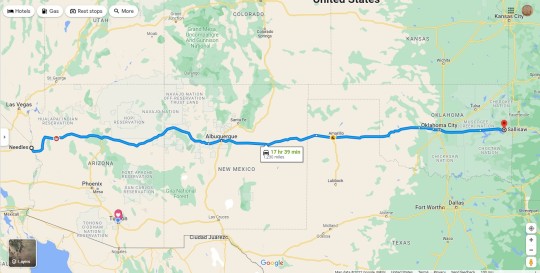
So, we have some motivation: desperation for any work. But how bad was the trip? Well, the actual road doesn't exist in total that I can see, but it ran parallel to the I-40. That major thoroughfare is still there and can be mapped directly from the start to end. According to Google Maps, the distance is 1,230 miles taking about 17 hours according to the posted speed limits. The Joad family, however, purchased a 1926 Hudson Super Six to fit 10 people and it was filled with a household full of stuff. This was actually a very fast car with a max speed of almost 80 mph at the time (according to Wikipedia), but the massive amount of weight and that it was almost consistently overheating meant that it would have taken at least 3 or 4 days to make the journey. Even if the car managed to get to 40 miles an hour on average (this is being generous with the weight, condition of the vehicle, and the terrible roads), then it would have taken 31 hours if there were absolutely no stops. My students and I combined all the factors and decided that desperation would push them forward, so the movie parameters would allow for about 3 days of travel to get between the two locations.
Now, a three day trip would suck, but would it actually be bad enough to kill somebody? I wanted to further explore the conditions of this trip with an analysis of some of the variables. The two people who died were both already the eldest and not in the best shape. They were also quite upset about the move. Both were conditions that would make them lose the will to live, but probably not enough to kill them both in a matter of days. Their mental faculty was not likely what would have killed them, but it definitely didn't help.

Another major thing was the heat. The threat of heat stroke was a major problem. Both of the elders were in the back and covered from the sun, but they were also blocked from any air movement and packed in with a bunch of others. The summer heat along this road is horrific, and I know this from personal experience. I currently reside pretty near Pheonix, and it can get into the temperature range of about 110-120 degrees Fahrenheit (40s Celsius) during the summer. In fact, according to the US Climate Database, summers in Needles, California can be the hottest in the world reaching as high as 126 degrees and holding the global record for a couple of days of the year. This can be deadly hot alone, but then driving in a car that is constantly overheating with no air conditioning and surrounded by body heat would make this a hazard especially over 3 days. What can be most stifling about the desert heat is that it never cools down completely. There have been 24-hour periods in my experience that never drop below 85 degrees. It is like this throughout the American Southwest and most of the trip would have been in this kind of sweltering heat.

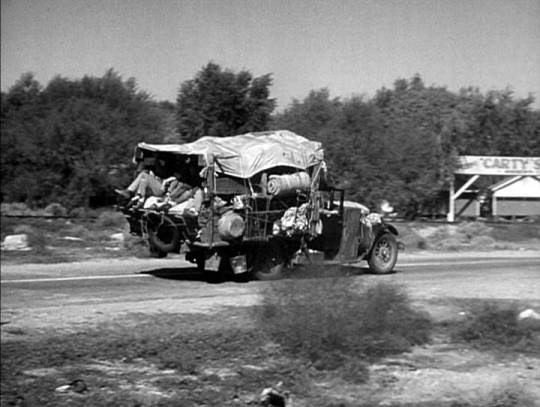
I think the proverbial and somewhat literal "nail in the coffin" was that the car was not working properly and most likely filling that back cab up with exhaust. It was closed off in a way so that no air would have been passing through despite being right next to the exhaust. My students and I agree that this jalopy is a death trap and driving it for three days in the desert heat could most certainly kill off an older person who was already sick.
-----------------------------------------------------------------------------
This was a fun exercise, but it also was depressing to think how many people likely died on the way to California. It was during the depression and so many people were already starving and in poor health, I can imagine that there are a lot of little unmarked graves along old Route 66. More like Route 666. Interesting. I wonder if anybody has ever done a project on the ghosts of Route 66. Could be something worth looking into...
#Route 66#grapes of wrath#american southwest#psychology#road trip#the great depression#john steinbeck
4 notes
·
View notes
Note
Pls suggest ur all time fav movie/series.
That is a hard question for a cinephile. I think the most complete movie that impressed me the most was Schindler's List. The movie that I find the most fun to watch and is crowd pleasing is The Princess Bride. My favorite animated film is Wizards. My favorite animated series is either Cowboy Bebop or Avatar: The Last Airbender. My favorite action beat-em-up is The Raid. My favorite western is High Noon. My favorite rom-com is The Apartment. My favorite silent film is Sunrise: A Tale of Two Humans. My favorite who-dunnit is The Third Man. My favorite quirky foreign film is Delicatessen or City of Lost Children. My favorite horror film is Evil Dead (by Sam Raimi). I think my favorite sci-fi is District 9. I have lots of favorites and it really depends. Very good question, though.
1 note
·
View note
Text
Movie Adaptations of Steinbeck novels
There are many prolific writers that have had many movies based on their novels and plays. Perhaps the best example of this as far as American films is the Depression Era author John Steinbeck. He wrote many novels about the California coast and many of them focused on the poor and unfortunate coastal farmers who suffered during the Great Depression and eventually World War 2. These books appealed to the poor and working class, so movie adaptions appeal to the common person who works hard to make a living. I was curious as to how many films were adapted because Steinbeck was a prolific writer, so I did some research and developed the following list of movies that are pretty good:
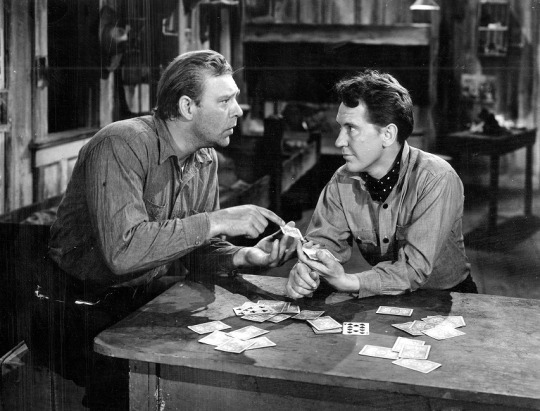
Of Mice and Men
This is arguably the best-known story of John Steinbeck and the symbolism behind the simple story is phenomenal. The title comes from a poem by Robert Burns in which the quote is actually, "The best laid schemes o’ mice an’ men, gang aft a-gley." The most apt English translation to current readers is "the best laid plans of mice and men often go wrong." It is the story of a man who is caring for a developmentally delayed relative during the Great Depression. He has big plans to retire and live off the fat of the land, but his partner ruins it every time. The more they plan, the worse things go wrong. This kind of story is perfect for a play or a movie, of which it was made into both. There was a Broadway play that was adapted from the book, followed by a feature film in 1939 and then another in 1992. A third adaption called Best Laid Plans was released in the UK in 2012 and was a modern take on the same story.

Cannery Row
I really enjoyed the book when I read it in high school. It is a bunch of short stories about the poor and desolate living in Monterey, California during World War 2. It is a fun bunch of vignettes, which is generally something I enjoy, and the 1982 film adaptation has some big names like Nick Nolte and Debra Winger. The film is sadly pretty average due to some production issues. The main issue was actually that Raquel Welch, who was supposed to play one of the leads, was fired after a couple of days and she sued the production company for $10.8 million. That equaled almost the entire budget so there was almost no advertising or promotion of any kind. The movie only made $2 million and is considered a complete flop. It is a good script from a good story, but it is definitely not one of the best movies.
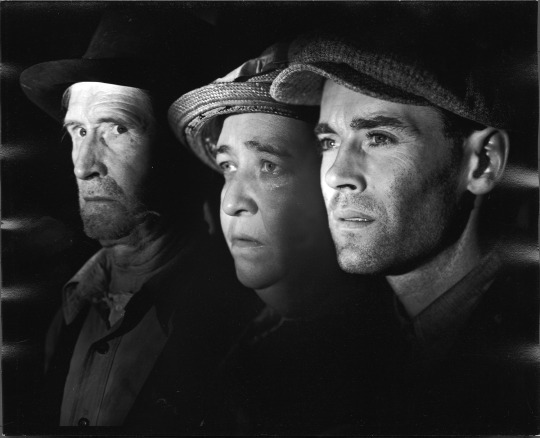
The Grapes of Wrath
This is the story of an American folk hero. He was a common man who was not good, but he worked hard to support his own family. Henry Fonda plays the protagonist Tom Joad, a man who got out of jail only to move with his family from Oklahoma to California to find work. Even in such hard times as the Great Depression, there were people who were running scams to benefit from the labor of the common man. I remember learning of this hero in a Rage Against the Machine song called "The Ghost of Tom Joad" that used the famous "I'll be there" speech in the lyrics. This film was nominated for seven Academy Awards including best picture. It is one of the few movies that has a 100% fresh rating on Rotten Tomatoes which shows it is a real crowd pleaser. The movie is a little slow and can seem a little like a documentary at times, but it is fascinating and relatable despite being over 80 years old. A fantastic film worthy of the Steinbeck story.
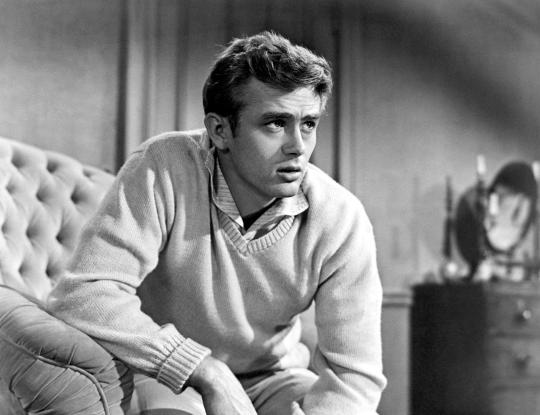
East of Eden
This is a great story of a small family that was trying to survive during World War 1 in the Salinas Valley. The main character is Cal, who was played by James Dean. This is one of the roles that Dean is famous for, along with Rebel Without a Cause and Giant. Sadly, that fame was partly due to the death of James Dean in a car crash only six months after this film was released. Dean was posthumously nominated for Best Actor in 1955 for East of Eden and 1956 for Giant. The novel was another work by Steinbeck that was required reading for high school in California. The story seems like a loose interpretation of Cain and Abel, which makes the film an adaptation of the play, which is an adaption of the Steinbeck novel, which is an interpretation of the bible story. That is a lot of degrees of separation, but it all comes back to the Bible.
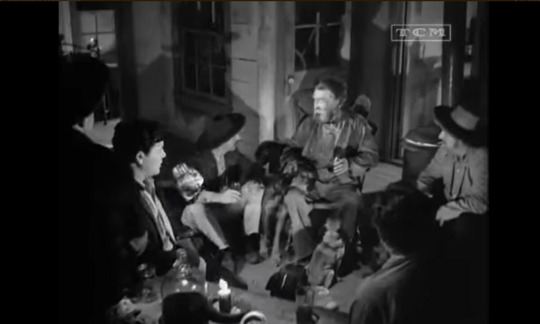
Tortilla Flat
The story is of a dark romantic tragedy that was changed to a comedy for the big screen. It was directed by Victor Fleming in 1942 (only three years after his success with Gone with the Wind and The Wizard of Oz) and stars Spencer Tracy and Heddy Lamarr. It is another example of the poor trying to make it in the little coastal town of Monterey, California. This time a man inherits two houses and houses himself and his friends in them. I am not that big of a fan of the film because the story was changed quite a bit for the big screen. In fact, one of the main characters is in an accident and dies in the book while they live in the movie. It is a huge change, making the story much less like a Steinbeck novel. I highly recommend the book over the movie, but the film is not that bad.

The Winter of Our Discontent
This story is like the opposite of It's a Wonderful Life. It is the tale of a man from an upper middle-class family that loses his inheritance due to a family member's mistakes. Instead of being supportive, his family and his neighbors criticize this lead character's integrity until he becomes more cutthroat. He turns in the new owner of his old family store to immigration and then tricks a friend out of some land. It basically comes down to the fact that the town and his family would have been better off without him. A TV-movie was adapted in 1983 and stars Donald Sutherland and Terri Garr. It's a very depressing story and a very depressing movie. As a side note, there was a very good episode of American Horror Story that was based on the book.
----------------------------------------------------------------------------
I am a big fan of Jon Steinbeck and his willingness to explore the underbelly of the California small towns during the worst of times. His stories reminded me that having a rough day at the office or getting in an argument was not that big of a deal. There were people that suffered every day of their life and had to find a reason to push forward every day they got up. I have worked hard, but I never had to bale hay by hand to barely make enough money for food. I never considered a fine meal being the time I had ketchup to put on my canned beans. I never considered a good living situation something that at least included a roof. It is a good reminder that things could be a lot worse, and I should count all of the many blessings that I have. For that, I will always be fascinated by the works of Steinbeck.
5 notes
·
View notes
Text
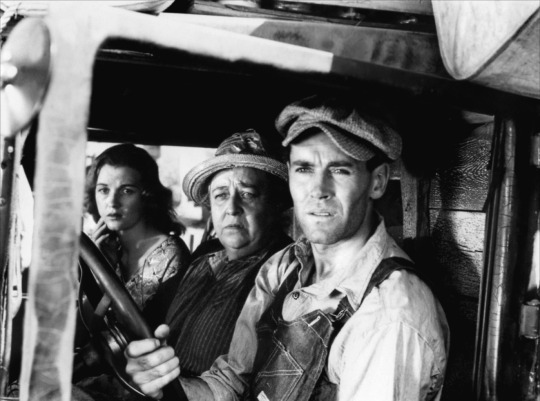
The next film on the AFI list is John Ford's adaptation of a John Steinbeck novel, The Grapes of Wrath (1940). The film was highly acclaimed with seven Oscar nominations and two wins for Best Director (John Ford) and Best Supporting Actress (Jane Darwell). This is a little bit of a departure from Ford's other highly acclaimed films since it did not feature John Wayne, but it did have the great Henry Fonda. The film is set in Depression era Central California, like most of Steinbeck's stories, so it was very much part of my high school curriculum. I have seen this film in an academic setting and on my own, but I am looking forward to watching it again. With that said, here is the trailer for the film, and please join with me (and enjoy with me) for The Grapes of Wrath.
1940 - The Grapes of Wrath Trailer - YouTube
14 notes
·
View notes
Text
Platoon (1986); AFI #86


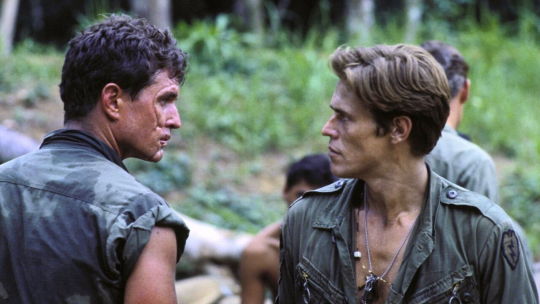
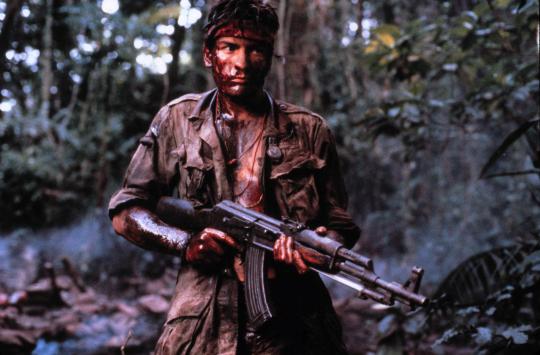
The most recent film for review is the last of our gritty war films from the AFI top 100: Oliver Stone directed Platoon (1986). This film took home four Oscars that year for Best Picture, Best Director, Best Sound, and Best Editing. Like many other big war films with many small parts, this film had a ton of current for the time and future stars. The cast includes almost no women since the film begins with the arrival of the main characters in Vietnam and ends with some of them leaving. Notable names include Charlie Sheen, Tom Berenger, Willem Dafoe, Keith David, Forest Whitaker, Francesco Quinn, Kevin Dillon, John C. McGinley, Johnny Depp, and Tony Todd. The only other war films I can think of with more star power are Saving Private Ryan or Apocalypse Now. The film has a much more interesting story than "kill the enemy," which is why I think it received so many accolades. I really want to get to some behind the scenes notes, but let's start out with a synopsis and a quick warning...
SPOILER WARNING!!! THIS IS A WAR FILM SO IT CANNOT BE GUESSED WHICH CHARACTERS MAKE IT THROUGH AND WHICH DON'T!!! I AM ABOUT TO SPOIL THAT!!! IF THAT IS OKAY, THEN KEEP READING! OTHERWISE, CHECK OUT THE MOVIE FIRST AND CHECK OUT THIS BOTTOM PART OF THIS ARTICLE AFTERWARD!!!
-----------------------------------------------------------------------------
In 1967, U.S. Army volunteer Chris Taylor (Charlie Sheen) arrives in South Vietnam and is assigned to an infantry platoon of the 25th Infantry Division near the Cambodian border. The platoon is officially led by the young and inexperienced Lieutenant Wolfe (Mark Moses), but in reality, the soldiers defer to two of his older and more experienced subordinates: the hardened and cynical Staff Sergeant Robert "Bob" Barnes (Tom Berenger), and the more idealistic Sergeant Elias (Willem Dafoe). An interesting note is that the first things Taylor sees upon landing are body bags being stacked onto an outgoing plane, implying that there is only one way to leave.
Taylor is immediately sent out with Barnes, Elias and veteran soldiers on a planned night ambush for a North Vietnamese army force. The NVA soldiers manage to get close to the sleeping Americans before a brief firefight ensues; Taylor's fellow new recruit Gardener is killed and Taylor himself lightly wounded. After his return from hospital, Taylor bonds with Elias and his circle of marijuana-smokers while remaining aloof from Barnes and his more hard-edged followers. There are many shots with Elias on the right and Barnes on the left, almost like an angel and devil on the shoulders of Taylor. To add to it, Barnes is scarred all over his face and body will Elias is basically untouched.
During a subsequent patrol, three men are killed by booby traps and unseen assailants. The injuries from the trap are hard to watch, so be prepared when the soldiers start looking around. One of the deaths is more obvious since a guard is displayed like a scarecrow as a message to the group. Already on edge, the platoon is further angered when they discover an enemy supply and weapons cache in a nearby village. This is the intense scene that the movie is famous for. One particular soldier called Bunny (Kevin Dillon) shows that the men in the platoon might be more dangerous than the NVA. Barnes, through a Vietnamese-speaking soldier, Lerner (Johnny Depp), aggressively interrogates the village chief about whether the villagers have been aiding the NVA, and cold-bloodedly shoots his wife dead when she snaps back at him. Elias then arrives, getting into a physical altercation with Barnes over the killing before Wolfe breaks it up and orders the supplies destroyed and the village razed. Taylor later prevents a gang-rape of two girls by some of Barnes' men.
When the platoon returns to base, the veteran company commander Captain Harris (Dale Dye) declares that if he finds out that an illegal killing took place, a court-martial will ensue, leaving Barnes worried that Elias will testify against him. On their next patrol, the platoon is ambushed and pinned down in a firefight, in which numerous soldiers are wounded. More men are wounded when Lieutenant Wolfe accidentally directs an artillery strike onto his own unit before Barnes calls it off. Elias takes Taylor and two other men to intercept flanking enemy troops. Barnes orders the rest of the platoon to retreat and goes back into the jungle to find Elias' group. Barnes finds Elias alone and shoots him, then returns and tells the others that Elias was killed by the enemy. While the platoon is extracting via helicopter, they glimpse Elias, mortally wounded, emerging from the tree line and being chased by a group of North Vietnamese soldiers, who kill him. Noting Barnes' anxious manner, Taylor realizes that he was responsible.
At the base, Taylor attempts to talk his group into fragging Barnes in retaliation when Barnes, having overheard them, enters the room and mocks them. Taylor assaults the intoxicated Barnes but is quickly overpowered. Barnes cuts Taylor near his eye with a push dagger before departing.
The platoon is sent back to the front line to maintain defensive positions, where Taylor shares a foxhole with Francis (Corey Glover). That night, a major NVA assault occurs, and the defensive lines are broken. Much of the platoon, including Wolfe and most of Barnes' followers, are killed in the ensuing battle. During the attack, an NVA sapper, armed with explosives, destroys the battalion headquarters in a suicide attack. Now in command of the defense, Captain Harris orders his air support to expend all their remaining ordnance inside his perimeter. During the chaos, Taylor encounters Barnes, who is wounded and driven to insanity. Just as Barnes is about to kill Taylor, both men are knocked unconscious by an air strike.
Taylor regains consciousness the following morning, picks up an enemy Type 56 rifle, and finds Barnes, who orders Taylor to call a medic. Seeing that Taylor won't help, Barnes contemptuously tells Taylor to kill him: Taylor does so. Francis, who survived the battle unharmed, deliberately stabs himself in the leg and reminds Taylor that because they have been twice wounded, they can return home. The helicopter carries the two men away. Overwhelmed, Taylor sobs as he glares down at multiple craters full of corpses.
----------------------------------------------------------------------------
I don't want to break down every single character in the film because that is everything there is. The film is much more about character development and Vietnam is just a setting. I believe that Oliver Stone wanted to emphasize that humans, when put into a hellish situation, had to choose between conforming to survive or trying to keep your own morals. Charlie Sheen plays Taylor, a young but moralistic person who entered the situation by choice in an attempt to prove himself. There is an authority figure of Lt. Wolfe, who is technically in charge, but it is the two sergeants that play a demon and an angel (they would be on his shoulder if this was a cartoon) that push Taylor towards conforming to evil or holding on to righteousness. Neither sergeant survives the film, and it is ambiguous how Taylor will act when he returns home, The only thing for certain is that he is very different from what he was when he arrived. Both Defoe and Berenger received nominations for best supporting actor for their roles, but neither won the award.
There is some mention of class in this film because it seems that it is mostly the uneducated masses who could not get away from the draft that fought in the war. It is this irony (those who have the least are forced to sacrifice the most) that is a focal point of the film. The character of Bunny, played by Kevin Dillon, finds war as an opportunity to get out his aggressions and attack something that represents his personal failures in life. A big gun and not much to live for is a dangerous combination, especially when a person with these attributes is trained to kill. Oliver Stone was a soldier in Vietnam and he really wanted to emphasize how the horror of the situation can bring out the worst in the downtrodden.
There are a group of black soldiers that are played by Tony Todd, Keith David, and Forest Whitaker. None of the three seem very interested in the politics of the situation as much as they just want to get away. Forest Whitaker's character sits on the middle ground and does what he is told, but he also expresses that he feels bad for his actions. Tony Todd's character sides with Barnes because he feels this is his best chance to survive long enough to get out. Barnes was shot and mangled, yet he still is alive, so he must be doing the correct thing. Keith David's character is trying to survive while also keeping his own morals, so he sticks with Elias and tries to do what he feels is right.
This film is what I would describe as a war drama since it is the Divine Comedy set in the jungles of Vietnam and Cambodia. There are no really good people and evil actions are understandable and sometimes almost relatable. It really makes the viewer upset that so many young men and women were put in this situation to be morally and mortally tested. It really affected audiences of the mid 80s, and that is why the film won for best picture.
One negative note about the production is the reported behavior of Oliver Stone. The film was shot in the Philippines and the push to make the film realistic bordered on abuse for the actors. The whole production was plagued with sickness and injuries with the actors having both Stone and advisor/actor Dale Dye yelling at them the whole time. There is a scene in which Tom Berenger is holding a gun to a little girl's head and he was told and berated into yelling and threatening the young actress until she really began to cry. Actors were allowed to leave as they were killed off since the film was shot almost completely in a linear fashion, so those looks of relief when they got on a helicopter to go home were quite genuine.
I was surprised that there was no nomination for make-up effects because the battle injuries look horrific and the scars on Tom Berenger were so realistic. I just thought that Berenger had scars all over his face until I saw him in another movie. He doesn't have the greatest skin, but the deep wound scars were blended in perfectly. The film would not have won since this award was eventually taken home by The Fly with Jeff Goldblum, but I still think a nomination was in order.
So, does this film deserve to be on the AFI top 100? Yes, but it is definitely lower on the list. It was shot in the Philippines and describes a war that America was not committed to, but it was still a major part of US history and touched a sensitive nerve for audiences at the time. The film is neither imaginative nor innovative, but the realism is worthy of recognition. Would I recommend it? That is actually kind of difficult. I wouldn't recommend it to a general audience because it will ruin your day. It is an engaging experience that transports the viewer to the war-torn jungle, but that is not something that many people really want. The film will affect you, just make sure that you are ready for it.
#platoon#war films#psychology#introvert#introverts#movies#great movies#best picture#academy award winner
10 notes
·
View notes
Text
youtube
One of the things that Oliver Stone's war film, Platoon (1986), featured was the classic Adagio for Strings, by Samuel Barber. Sustained, building, and deep, the strings create a feeling that has been described as the perfect audio interpretation of regret. The piece was played in the background when Franklin Delano Roosevelt's death was announced over the radio and again at Albert Einstein's funeral. The piece was also played at the Royal Albert Hall to honor the victims of the 9/11 attacks and then again during the 20th anniversary of the attacks. It is a very deep and moving piece that brings tears to the eyes of the audience.
In the film, it is used to represent regret for leaving for Vietnam, regret at the loss of brothers in arms, regret for those actions taken out of retribution, regret for not taking action, and regret for the loss of innocence in a hellish jungle. It is also the background of the most dramatic death scene probably ever recorded. The piece has now become a part of the film Zeitgeist and indicates overwhelming feelings of regret. It is also sometimes uses to parody a death that is overly dramatic. Either way, the piece has become deeply symbolic in the language of film.
4 notes
·
View notes
Text

There are only 3 more films to review from the AFI top 100. We will start with the epic war drama Platoon (1986), directed by Oliver Stone. This was the first of a trilogy of gritty Vietnam war films by the director and includes Born on the Fourth of July (1989) and Heaven and Earth (1993). Oliver Stone is reported as the first Vietnam vet to write and direct a Hollywood film. Audiences really responded to the horrors of war depicted in the film, which was nominated for eight Oscars. The film took home four Academy Awards for Best Picture, Best Director, Best Sound, and Best Editing. This a very harsh film that portrays some American soldiers as villains, making it unpopular with some veterans. I definitely want to give a content warning on this one, so make sure to be ready before just diving in. I am very interested to see what others think of this film, but I don't want to push anyone into something that is scarring. Here is the trailer to give an idea of what it is all about:
(1) Platoon Official Trailer #1 - Charlie Sheen, Keith David Movie (1986) HD - YouTube
9 notes
·
View notes
Text
Forrest Gump (1994); AFI #76
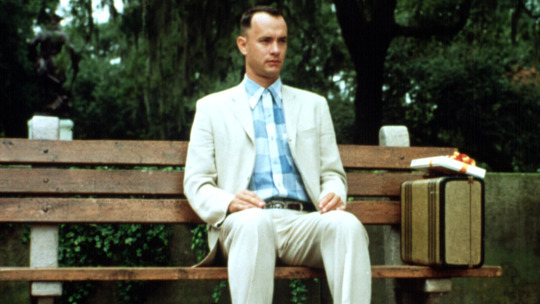
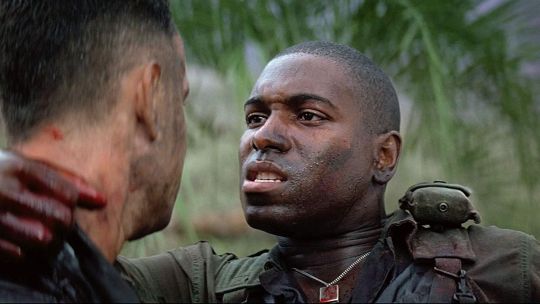


The next film that was reviewed for the AFI top 100 was perhaps the most Americana movie of them all, Forrest Gump (1994). This is the story of a relatively simple man who truly experiences life by doing what people tell him he should do. The film won at the Academy Awards for Best Picture, Best Actor, Best Director, Best Visual Effects, Best Adapted Screenplay, and Best Editing. Tom Hanks won his second consecutive Best Actor role after winning for Philadelphia the previous year, and this really put his stamp down as an A-List talent with huge box office draw. Robert Zemeckis was finally recognized by the Academy for the consistently good work he had done in the 80s and 90s for films like Romancing the Stone (1984), Back to the Future (1985), and Who Framed Roger Rabbit (1988). The story of Forrest Gump is quite the journey (quite literally), so I want to go through it before pointing out some behind the scenes aspects of the film. This, of course, means that wonderful part of all of my reviews:
SPOILER WARNING!!! THIS IS A GREAT STORY AND THERE ARE DEFINITELY SOME ASPECTS TO SPOIL, SO PLEASE CHECK OUT THE MOVIE BEFORE READING ANY FURTHER! IT IS WORTH SEEING WITHOUT KNOWING THE ENDING!
----------------------------------------------------------------------------
In 1981, at a bus stop in Savannah, Georgia, a man named Forrest Gump (Tom Hanks) recounts his life story to strangers who sit next to him on a bench. He makes the very famous statement that really frames the entire film: "Life is like a box of chocolates; you never know what you're gonna' get."
In 1956, in Greenbow, Alabama, young Forrest is fitted with leg braces to correct a curved spine since he is unable to walk properly. Forrest is named after the founder of the Klu Klux Klan as a reminder what foolish things people do. His father ran away (his mom calls it being on vacation), so he lives alone with his mother (Sally Fields), who runs a boarding house. Forrest has an IQ of 80, which should keep him from the public school, but his mother works out a deal with the principal. Mrs. Gump is very shrewd and is able to attract a lot of interesting characters to their home including a young Elvis Presley, who plays the guitar for Forrest and incorporates Forrest's jerky dance movements into his performances. Being able to attend school, Forrest takes the bus and meets a girl named Jenny Curran, and the two become best friends.
Forrest is often bullied because of his physical disability and low intelligence. One of those things suddenly changes because, while fleeing from several bullies (Run, Forrest, run!), his leg braces break off, revealing Forrest to be very fast. Forrest and Jenny (Robin Wright Penn) remain best friends through to college age, and the bullies continue to chase him. During one particular escape, Forrest is discovered by University of Alabama coach Bear Bryant. This talent for running gets Forrest a football scholarship and a college education. At his time at the college, he is coached by Bear Bryant, witnesses Governor George Wallace's Stand in the Schoolhouse Door (during which he returns a dropped book to Vivian Malone Jones), becomes a top kick returner, is named to the All-American team, and meets President John F. Kennedy at the White House.
After graduating college in 1967, Forrest enlists into the U.S. Army. During basic training, he befriends a fellow soldier named Benjamin Buford Blue (nicknamed "Bubba" and played by Mykelti Williamson), who convinces Forrest to go into the shrimping business with him after their service. Later that year, they are sent to Vietnam, serving with the 9th Infantry Division in the Mekong Delta region under Lieutenant Dan Taylor (Gary Sinise). After months of routine operations, their platoon is ambushed while on patrol, and Bubba is killed in action. Forrest saves several wounded platoonmates – including Lieutenant Dan, who loses both his legs – and is awarded the Medal of Honor for his heroism by President Lyndon B. Johnson.
At the famous anti-war March on the Pentagon rally, Forrest briefly reunites with Jenny, who has become a drug addicted hippie and anti-war activist. He is kicked out of a Black Panther meeting when he defends Jenny from an abusive boyfriend. He also develops a talent for ping-pong and becomes a sports celebrity as he competes against Chinese teams in ping-pong diplomacy, earning him an interview alongside John Lennon on The Dick Cavett Show, influencing the song "Imagine". He spends the 1972 New Year's Eve in New York City with Lieutenant Dan, who has become an alcoholic, embittered about his disability and the government's apathy towards Vietnam vets. Forrest's ping-pong success eventually leads to a meeting with President Richard Nixon, whose administration get him a room in the Watergate complex, where he unwittingly exposes the Watergate scandal.
Discharged from the army, Forrest returns to Greenbow and endorses a company that makes ping-pong paddles. He uses the earnings to buy a shrimping boat in Bayou La Batre, fulfilling his promise to Bubba. Lieutenant Dan joins Forrest in 1974, and they initially have little success. After their boat becomes the only one to survive Hurricane Carmen, they pull in huge amounts of shrimp and create the Bubba Gump Shrimp Company, after which Lieutenant Dan finally thanks Forrest for saving his life. Lieutenant Dan invests into what Forrest thinks is "some kind of fruit company" (MacIntosh) and the two become millionaires. Forrest also gives half of his earnings to Bubba's family for inspiring the venture. Forrest then returns home to his mother and takes care of her as she dies of cancer.
In 1976, Jenny – in the midst of recovering from years of drugs and abuse – returns to visit Forrest. He starts to realize how angry she is with her life and father, so he of course decides to propose to her. She says no because she will only hurt him, but that night she tells Forrest she loves him and the two make love, but she leaves the next morning. Heartbroken, Forrest goes running "for no particular reason", and spends the next three years on a relentless cross-country marathon, becoming famous again before returning to Greenbow. This so beautiful because Forrest is so lost without Jenny or his momma, so he falls back on the only thing that he really knows how to do.
In 1981, Forrest reveals that he is waiting at the bus stop because he received a letter from Jenny, who asked him to visit her. Forrest is finally reunited with Jenny, who introduces him to their son, Forrest Gump Junior. Jenny tells Forrest she is sick with an "unknown virus" and the three move back to Greenbow. Jenny and Forrest finally marry, but she dies a year later. The film ends with Forrest seeing his son off on his first day of school.
-----------------------------------------------------------------------------
This film has a lot of greats, but also a couple of bads. The story is very engaging and turns into the most nostalgic American history lesson of all time. Tom Hanks plays a constant fish-out-of-water character, because Forrest has intelligence levels, which lead to a constant need for explanation. It is a fantastically filmable concept and Zemeckis takes full advantage of it.
Speaking of filming, the cinematography is absolutely gorgeous. The different shots that replay those historical moments (the integration at the University of Alabama, the Mekong Delta during the war, the protest at Washington DC), the beauty of the American roads, the Bayou when they are shrimping, and the giant Gump property are all beautiful. They also did a pretty good job of editing Forrest into stock footage as far as the body goes. It was groundbreaking at the time, but it can be done in After Effect by Youtubers at this point. What was not impressive and obviously does not hold up is the face tracking. Specifically bad are the presidents and John Lennon when they altered the mouths on historical footage to try and make them say different things. It is terrible. It does not break the movie, but it is both noticeable and laughable, especially since the film won the Oscar for Best Visual Effects.
The score written for the film is simple and elegant, really adding to the mood and the tone. The songs can be somber and a little sad, but there is this child-like simplicity that is constantly hopeful and moving forward. Very much like Forrest Gump. The rest of the soundtrack follows the popular rock anthems of the time and the whole thing is a pleasure to listen to. I used to just let it play when I was trying (with moderate success) to do my calculus homework in high school.
The statements that Forrest Gump makes throughout the film carry more and more weight as we realize that he is saying these things from his own experience and not just because somebody told him. The phrase "I am not a smart man, but I know what love is" is so powerful coming from Forrest. He says this after Jenny turns him down for marriage, and it becomes apparent that his loss of Bubba and his mother taught him what caring for somebody really means. He might not be able to give a psychological definition of love, but he has experienced it. Beautifully written and emotionally delivered.
One other thing that might be good or bad, depending on how you see it, is that the movie is blatantly sentimental. It tugs at the heart strings, but it is really trying to do it. Bubba dies, Lieutenant Dan loses his legs, Jenny is constantly in trouble, Mrs. Gump dies...all of these things have the same downward shots with somber music. These scenes are all followed up with forward movie scenes and uplifting music. The film constantly pulls the audience all over the place, which makes the tone go all over the place. Knowing that this was Robert Zemeckis directing, it makes me think that this was purposeful. Forrest Gump had a very difficult time knowing what was going on, so he depended on the context and what people said to tell him how he should feel. The audience truly experienced what it was like to be Forrest, and we all went on a life journey with him
One thing that I saw when browsing through interviews was that the unknown virus that Jenny died of was not AIDS. It was supposed to be Hepatitis, according to the director, the author of the source material, and the screen writer. AIDS was just the major disease on the global mind at the time, but it wasn't that common in the early 80s. It was hard to tell because most deaths close to Forrest were not shown at the point of passing. Forrest doesn't want to talk about those moments, and he is the real narrator.
Does this movie belong on the AFI top 100? Of course. This is the most Americana film I know of, and it showcases a simple view of two decades of the American experience. Would I recommend it? Hell yeah! This movie is a whole lot of fun and a really easy watch. There are some technical flaws, but the story and acting are superior to just about anything else I have seen.
10 notes
·
View notes
Text
1994: A Great Year for Cinema
There seems to be a strange nostalgia for previous times amongst teens who did not live through that time. From what I have observed, the favored decade seems to be about 25-30 years prior to the current time. This specific time discrepancy makes me theorize that it has something to do with parents sharing their childhood stories with their kids, but I have no proof or research on this. I have noticed that as we have moved into the 2020's, the focus has shifted from the 80s to hit squarely on the 90s. This was my formative decade in which I was a teen and really first started to realize what was going on in the world. One thing that stands out to me was my introduction to quality film, and the best year for film in that decade was 1994. I want to take a little trip back to the mid 90s, and we can take a look at some of the great (and a couple terrible) films from the mid 90s. Minor Spoiler Warning: I am going to summarize some films with some spoilers, so be aware before reading further.
--------------------------------------------------------------------------
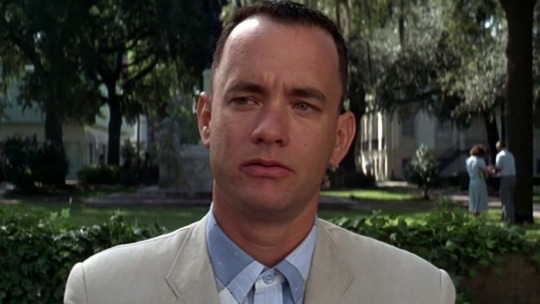
Forrest Gump
This was the eventual Best Picture winner in a very contentious year for films. This is most definitely a complete story and deserving of the high praise it received. Tom Hanks also won the award for Best Actor and Robert Zemeckis won the award for Best Director. The movie is very memorable and the lines from Forrest are so quotable that it has made a lasting impression on the American subconscious. Definitely one of my favorite movies of all time and one of the best films to come out of the 90s.

Pulp Fiction
This was Quentin Tarantino's masterwork in the eyes of many and it was an example of standout acting for Samuel L. Jackson, John Travolta, and Uma Thurman. This film paved the way for heavy dialogue and slick characters in mainstream action films that came after this. On the note of mainstream, this film was technically considered an independent film at the time, but all of the accolades have promoted it into the mainstream. Because of the non-linear timeline, this film is one of the most rewatchable pieces of media ever created.
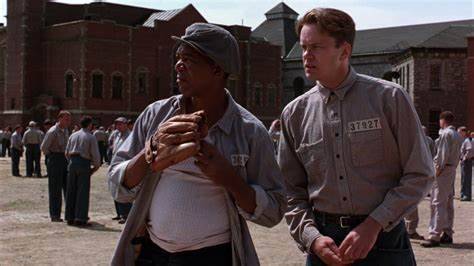
The Shawshank Redemption
Arguably the best Stephen King adaptation of all time, this film is filled with great performances and a great script. The score is exceptional, and the cinematography is stand out. It is still ranked the best film of all time on IMDB members poll, and the Academy said they would have given this film Best Picture over Forrest Gump if the award was given today. Although I love Tom Hanks, this was objectively the smartest story and the best acting of the year. The prison escape reveal might be the best 10-15 minutes of storytelling in a Hollywood movie ever.

The Lion King
The highest grossing film of 1994, this was one of Disney's most successful animated films of all time. The music is great, the story is based off the Shakespearean story of Hamlet, and the animation was fantastic. Truly one of the Disney classics.
Interview with the Vampire
Cans you imagine a movie with both Brad Pitt and Tom Cruise? I can. This was a time when Ann Rice was writing horror novels that were bringing attention back to vampires and gothic atmosphere. This was also the breakout role for Kirsten Dunst, a little fashion model at the time. This was actually a really good movie and Tom Cruise as Lestat was pretty amazing. Definitely worth a watch.
Four Weddings and a Funeral
This was the beginning of the Hugh Grant as a romantic lead series written by Richard Curtis. This was the beginning of some of the most successful rom coms including Notting Hill, Bridgette Jones Diary, and Love Actually. Everybody loved that bumbling Hugh Grant character around the turn of the millennium, and this started it all. The film was actually nominated for both Best Picture and Best Original Screenplay. It was extremely well written, especially for a romantic comedy.
Ace Ventura: Pet Detective
I don't like this movie at all, but I recognize what a large effect it had on American culture. People who liked the film quoted lines incessantly and tried to convince others about how genius it really was. People who hated it used it as a point of reference about how bad movies had become. Either way, everybody was talking about this film in the mid 90s.

Dumb and Dumber
Why is Jim Carrey the king of smart dumb comedies? Well, the year was 1994 and he starred in two of the dumbest, strangely-praised-by-other-comedians films ever. This film and Ace Ventura really established Carey the go-to physical comedian for many years. Again, not a movie that I personally enjoyed, but worth giving a chance because some people really loved this movie.
Reality Bites
Not that great of a movie, to be honest, but maybe the most 90s grunge film of all time. It has a killer soundtrack and stars Winona Ryder, Ethan Hawk, Janeane Garofalo, and Ben Stiller. It is quite a Gen-X story of young adults in the 90s: something that Millennials seem to be very curious about.
Speed
This was a big, dumb action movie that really solidified Keanu Reeves as an action film badass and Sandra Bullock as a leading love interest. I have seen this film many times and always laugh at how stupid it is...yet, I go back and watch it again and really enjoy it. Maybe it is a guilty pleasure, but I feel it is a fun, dumb movie.

The Crow
This was a fantastic dark action film based on a comic. This was a start to things like Spawn and Blade, which eventually lead to things like Guardians of the Galaxy and Deadpool. This was also famously the film in which Brandon Lee (son of Bruce Lee) was accidently killed on set. The irony and tragedy behind the film made this a really memorable viewing experience. And the film was pretty good to boot.
True Lies
This was a James Cameron big budget action film that was the third highest grossing film of the year. This is Arnold Schwarzenegger at his best: making witty puns, looking buff, and shooting the crap out of everything. This was also early days for the American Harrier Jet, the one that could hover like a helicopter. Tons of explosive action with an actual good story.
Clear and Present Danger
Tom Clancy novels were very popular amongst upper- and middle-class dads. My dad was definitely part of that group. It was a lot like taking Indiana Jones and sticking him in a more current era. This was the middle movie of the Clancy books that were turned into films, the others being The Hunt for Red October, Patriot Games, The Sum of All Fears, and Without Remorse. Clancy stories were also adapted into video games like Rainbow Six. Tom Clancy was very big in the 90s.

Natural Born Killers
This movie is quite the visual presentation. It is very similar to the way that Rob Zombie filmed his Devil's Rejects trilogy. Lots of psychedelic lighting, weird camera angles, and extreme violence. This movie was directed by Oliver Stone and based on a screenplay by Quentin Tarantino (who eventually disowned the film). The film was ranked in the top 10 most controversial by Entertainment Weekly. What I remember most about it is my mom getting motion sickness when we saw it at the theater.
The Adventures of Priscilla, Queen of the Desert
A very important film to the LGBTQ+ community, this is the story of two drag queens and a transgender woman who are traveling through the Australian Outback in a tour bused called Priscilla. It is one of the few completely positive portrayals of LGBTQ+ individuals at the time, and the film has gained quite a following since. It stars Hugo Weaving and Guy Pierce in solid acting performances. This was a rather big hit with worldwide audiences, making $31 million off of a $2 million budget. This kind of success was a sign that the world at large was aware of the LGBTQ+ community and ready to begin the process of acceptance.
Quiz Show
This was a standout film that was nominated for Best Picture, but very much faded away into obscurity. It is the story of a cheating scandal on a game show back in the late 50s, something that would most definitely get a Netflix original today. The 50s were popular in the 80s and the 90s seem to favor the hippie era, which was very anti-establishment created in the 50s. The movie was considered long and boring by the younger movie going public, so it never got into the pop culture subconscious. It is still a fantastic movie.
Ed Wood
This movie has become a cult classic as reviewing bad movies has become popular. Groups like MSTK3000, RiffTrax, and Red Letter Media have made watching bad movies a fun past time. This is the story of the original bad movie maker, Ed Wood, and his film Plan 9 From Outer Space. Considered by many to be the worst film of all time, Plan 9 is filled with technical errors, terrible acting, and ridiculous settings and props. It is so bad that it is actually very enjoyable, and Ed Wood is the story of how the director managed to make the film. It stars Johnny Depp and is probably my favorite acting performance by him. Well worth a watch and it will make you want to check out some really poorly produced movies.
Hoop Dreams
This was a fantastic documentary that got rave reviews and no Oscar nominations. It is the story of a couple of kids in poor neighborhoods that were attempting to have a career as basketball players. This was a truly insightful look into the lives of talented individuals who were unfortunately born into poverty and how hard it is to "make it." It was a running joke to make fun of the Academy for a while for this egregious snub because the movie was ironically about big institutions ignoring people with low socio-economic status.

Clerks
Do you like the quick moving dialogue of Kevin Smith movies? Do you like Jay and Silent Bob? This one is the original made for less than $30,000 and made over $3 million at the box office. There is no action and no special effects, it is just a really well written story by Kevin Smith. It's not even filmed in color. It is a great example of a creative mind that just grabbed a camera and filmed their vision the best they could. Truly a micro budget success story.
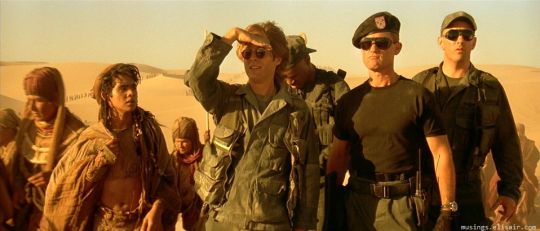
Stargate
This was the beginning for the very popular sci-fi franchise. It stars Kurt Russell and James Spader as soldiers who go through an interdimensional passage and stop an alien who is ruling an Egyptian like culture. This was the work of Roland Emmerich before he started churning out garbage like Godzilla (1998), The Day After Tomorrow, and 10,000 BC. There were later accusations that Emmerich stole his ideas from Dr. Who and the film has lost favor because of the white savior spin. The TV show is very different and a lot better, but this is what started it all.

Leon: The Professional
I have written many an article about how great this film is, and I will continue to claim it as one of my favorite films. The acting of Jean Reno and Natalie Portman as the most unlikely of assassin partners is amazing. It is also the first film I had seen by Luc Besson, and I have since become a big fan. The concept that an abused young girl would be rescued and mentored by an assassin is the kind of concept that should be explored by film. Astounding movie that really needs to be seen.
Immortal Beloved
This was an interesting film that followed a trail of historical clues to try and track down Beethoven's lover that he mentioned in letters written right before his death. The woman was referred to only as "my immortal beloved." I don't want to give the film more credit than it deserves, but it does follow a similar path as Citizen Kane. Both films are a voyage of discovery about powerful men through interviews of their peers and acquaintances to find meaning in some enigmatic last words.
The Color of Night
I put this film on here because it has quite the reputation. It is one of the worst movies ever made (it won the Razzie for worst picture that year) and verges on softcore pornography at some points (Maxim magazine singled the film out for the best sex scene of all time). It is a film noir that is completely confusing with a terrible performance by Bruce Willis. By the way, Bruce Willis plays a psychologist that deals with the death of a client he couldn't save. Maybe M. Night Shyamalan was a fan?
Cemetery Man (Dellamorte Dellamore)
This is just a personal favorite, but man do I like this film. It is a French film in which an undertaker is forced to go out zombie hunting because the bodies in his cemetery keep coming back to life. It is so funny because Rupert Everett plays the character as simply inconvenienced because he has to keep killing off zombies. Things change when he finds somebody who died that he wants to come back. He also happens to have a little Igor-like assistant that helps around the grounds. It is really good if you like horror.
The Mask
Here is Jim Carrey again and I would doubt that anyone would argue that this wasn't his best year as far as films. This was standout my favorite Carrey film of the 3 that he put out in 1994 and also was the breakout role for Cameron Diaz. The over-the-top cartoonish nature of the film really fits Carrey's acting style and is one of my favorite roles I have ever seen him in. He also has a song credit for Cuban Pete, which is quite a catchy song and dance number in the movie.
The Santa Clause
Not my favorite, however, this film has been voted the best Christmas film by many outlets. It stars Tim Allen as a man who is forced to take the role of Santa Claus. There is a heartwarming story of a divorced dad bonding with his son and finding a place in the lives of his ex-wife and her new husband. It is pretty sappy, but that is exactly what most people want in a Christmas film.
--------------------------------------------------------------------------
There were 100s of movies that came out that year and I remember going to the mall on a pretty regular basis to check out a flick. Another thing I remember about that year was the number of new faces that I would see rise to stardom. In that group of debuts was Jessica Alba, Claire Danes, Cameron Diaz, Scarlett Johansson, Jude Law, Haley Joel Osment, Natalie Portman, JK Simmons, Kenan Thompson, Mark Wahlberg, Chris Tucker, and Kate Winslet. In my opinion, it was an amazing year for movies and a good place to start if you want to get a real feel for 90s popular culture.
24 notes
·
View notes
Text

The next movie on the AFI top 100 was the Academy Award winner for Best Picture in one of the most competitive years of all time, Forrest Gump (1994). This picture also won Tom Hanks his second consecutive Best Actor Award for the portrayal of a developmentally delayed but world wise man born in Alabama in the 40s. He has adventures meeting presidents and rock n' roll greats, going to war in Vietnam, and running around the country. This might be my favorite "life of adventure" movies and this guy seems like somebody I would want to just sit and listen to. Great fashions style as well. This film is most definitely a fun one (despite some rather harsh war scenes) with one of the best soundtracks of classic rock ever made. Join me in rewatching because this film has become a large part of Americana and acts as the best history lesson of all time. A lot of fun and I really look forward to it.
3 notes
·
View notes